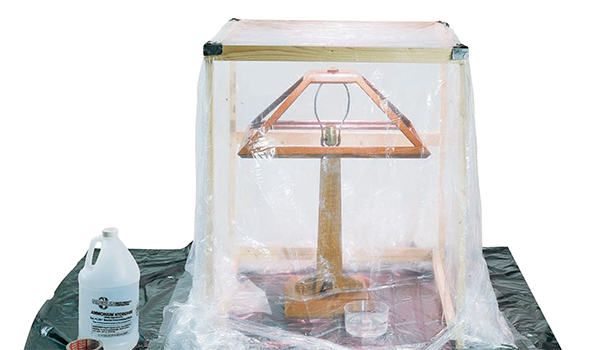
It’s a finishing technique used in Mission style furniture. What strength ammonia is required and where to obtain it? Does it require heat and how much heat? How long does the process take, and how much ammonia is required? Does anyone have any ideas for the “Fuming Chamber”?
Michael Dresdner: Fuming is a dangerous process, so gear up with eye protection, respirator, and gloves. Suit up BEFORE you open the jug, or open the chamber. Use 35% solution ammonium hydroxide, which you can get from a chemical supply house or blueprint supplier (this is the ammoniaused in blueprint machines — something becoming increasingly rare thanks to computer plotters.) The ammonia generates fumes that are trapped in a chamber — hence, very little is required, since a small amount will generate a good bit of fumes. One bowl will do a tented table or chair, and a gallon will do an entire chamber full of furniture. Naturally, it can be used again and again.
The longer the furniture is in the chamber, the darker it gets. Typical schedules go from 12 hours (a very light fuming) to 72 hours (rather dark). Test scraps first.
The temperature in the chamber not only affects speed of fuming, but also color. The hotter the chamber, the more reds it brings out. Colder chambers result in a more greenish brown. Make one section of the chamber of clear plastic, and shine a heat lamp into it. Remember, ammonia corrodes aluminum, so no electrical connections should be inside the chamber. You’ll notice that when the air inside gets up to 80 or 82 degrees, the reaction goes faster and the colors get slightly redder.
A simple chamber can be nothing more than a frame draped with clear or black 2 mil plastic. Make the frame of wood scraps or plastic pipe — anything that will hold up plastic and surround the piece you are fuming. Seal the plastic at the bottom with duct tape. (Obviously, don’t fume on a wood floor — fuming works even through most finishes.) For a more permanent, reusable one, try one of those ubiquitous Rubbermaid storage sheds. Close it and seal up the edges and seams with duct tape.





